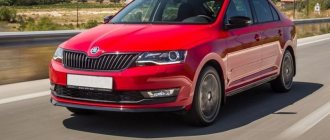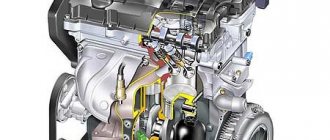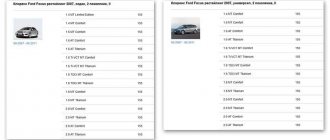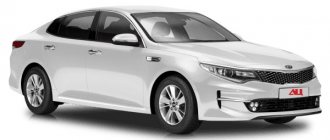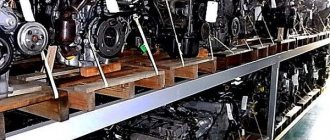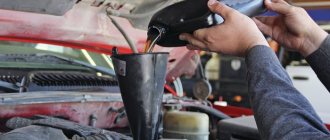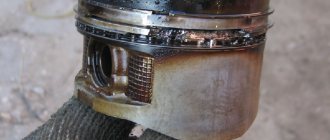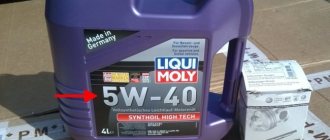The third generation of the Skoda Octavia uses specially developed modern turbocharged petrol and diesel engines. Fuel consumption and exhaust emissions of the new power units decreased by 23% compared to their predecessors. There are 8 engine versions in total: four petrol TSI and four diesel TDI. In Russia, the Skoda Octavia was initially sold with three versions of turbocharged gasoline engines (1.2, 1.4 and 1.8 liters) and one 2-liter diesel engine. However, subsequently the modification with the junior 1.2 TSI engine was replaced by a modification with a naturally aspirated 1.6 MPI engine. Below are the characteristics of all 5 power units
Petrol engine 1.2 TSI (index CJZA)
The entry-level 1.2 TSI Green tec engine, which includes a Start/Stop system and braking energy regeneration, has a power of 105 hp. with fuel consumption in the combined cycle of 5.2 l./100 km. The maximum torque of 175 N*m is maintained in the range from 1400 to 4000 rpm. Carbon dioxide emissions into the atmosphere are only 114 g/km. The engine can be paired with either a 5-speed manual gearbox or a 7-speed DSG automatic transmission.
Transmission
For people who value low operating costs, a manual transmission is recommended. However, there are also problems with it - the rear dual bearing is destroyed. The mechanical clutch lasts more than 150-200 thousand km.
An automated DSG transmission can be a big drain on the wallet due to the need for control electronics repairs and costly oil changes after 100,000 km. Most often, owners had to deal with replacing the clutch (about 25,000 rubles) or mechatronics even after a mileage of 50-100 thousand km. At the end of 2013, the problem units were finalized, and troubles began to occur less frequently. It is worth noting that recently some specialized services have learned to repair mechatronics.
The 6-speed automatic 09G (Aisin TF-60SN) is very reliable. Provided that the oil is regularly updated and handled with care, it can easily cover more than 250-300 thousand km. Otherwise, the first service visit is guaranteed after 150,000 km. The cost of repairs will be from 40 to 100 thousand rubles.
Petrol engine 1.6 MPI (CWVA index)
The only naturally aspirated power unit in the Skoda Octavia A7 engine line. It is significantly inferior to turbocharged engines in power and peak torque, and also consumes more fuel. Maximum thrust of 110 hp. supported by such a motor in a fairly narrow range of 5500-5800 rpm. Maximum torque is achieved at 3800 rpm. More information about the 1.6 MPI 110 hp engine. see here.
Some conclusions
The appearance of the 1.6 MPI 110 hp engine in the range of Skoda Octavia A7 engines. can definitely be regarded as a positive thing. Car enthusiasts have more freedom in choosing power plants and gearboxes. The new unit was developed in accordance with the latest trends in engine construction, complies with Euro-5 environmental standards, and has good consumer properties. In addition, the power unit is assigned the role of a base unit, that is, the modifications it comes with are the cheapest. As of October 2021, the price for the Skoda Octavia 1.6 MPI starts at 899 thousand rubles (version with 5-speed manual transmission).
At first, Octavias for the Russian market were equipped with 110-horsepower foreign-assembled engines. In September 2015, engine production was launched at the plant in Kaluga. Currently, the 1.6 series EA211 is installed on several Volkswagen/Skoda models at once. In addition to the Octavia, this number includes Yeti, Rapid, Polo and Jetta.
Other articles in the "Useful" section
Helpful information
Cost of owning Skoda Octavia
Helpful information
Skoda Octavia A7 Owner's Manual
Diesel engine 2.0 TDI
The third generation Skoda Octavia is supplied to Russia with one version of a 2-liter diesel engine with a power of 143 hp. Carbon dioxide emissions are just 119 g/km and fuel consumption is 5.1 l/100 km. Maximum torque of 320 N*m is achieved in the range of 1750-3000 rpm. The 2.0 TDI engine is also available with an automatic transmission.
Skoda Octavia II - typical problems and malfunctions
— in gasoline engines with direct fuel injection, carbon deposits accumulate in the intake manifold;
- the old 16-valve engine with a displacement of 1.4 liters had problems with the lubrication system - in winter the crankcase gas exhaust channel froze;
- in 1.4 TSI engines, problems arise with the timing chain tensioner; the chain may jump or even break. Sometimes the injectors also fail;
— typical malfunctions of the 1.8 T: ignition coils, timing chain and oil supply;
— failure of the exhaust gas recirculation valve. Cleaning it, unfortunately, won't help;
— DSG double-clutch gearboxes often required expensive repairs after 100,000 km;
— the turbocharger of the 1.9 TDI engine can withstand more than 150,000 km; in the previous generation it served more than 200,000 km.
Summary table of engine characteristics of Skoda Octavia A7
| Engine | 1.2 TSI (currently not sold in Russia) | 1.4TSI | 1.6MPI | 1.8 TSI | 2.0 TDI |
| engine's type | petrol with direct fuel injection and turbocharging | petrol with direct fuel injection and turbocharging | petrol with distributed injection | petrol with direct fuel injection and turbocharging | diesel with direct fuel injection and turbocharging |
| Engine location | front, transverse | front, transverse | front, transverse | front, transverse | front, transverse |
| Working volume, cubic meters cm. | 1197 | 1395 | 1598 | 1798 | 1968 |
| Compression ratio | 10.5 | 10.5 | 10.5 | 9.6 | 16.2 |
| Number of cylinders | 4 | 4 | 4 | 4 | 4 |
| Cylinder arrangement | in-line | in-line | in-line | in-line | in-line |
| Cylinder diameter, mm | 71.0 | 74.5 | 76.5 | 82.5 | 81 |
| Piston stroke, mm | 75.6 | 80.0 | 86.9 | 84.1 | 95.5 |
| Number of valves | 16 | 16 | 16 | 16 | 16 |
| Power, hp | 105 | 140 | 110 | 179 | 143 |
| Maximum torque, N*m | 175 | 250 | 155 | 250 | 320 |
The turbocharged petrol engines of the new Octavia belong to the EA211 series, developed by the Volkswagen concern. They have an in-line configuration with 4 cylinders. The main advantage of these power units is the significant reduction in fuel consumption and emissions due to optimized thermal management.
The new engines are fundamentally different from the previous EA111 series. They have become more compact - the installation length has been reduced by 50 mm; The installation system was also optimized. Both the cylinder block itself and the crankshaft with connecting rods and pistons lost significant weight. To cool the EA211 engine, a dual-circuit system is used: the high-temperature circuit cools the engine itself, and the low-temperature circuit cools the cylinder head.
The EA288 diesel engines have also been significantly redesigned, making them more economical than the previous generation. A number of components have been modernized, including changes to the exhaust system. An innovative thermal management system with separate circuits now allows the engine to warm up much faster, which is especially important in winter.
see also
Technical characteristics of the Skoda Octavia A7
Options and prices of Skoda Octavia A7
Skoda Octavia second generation model
The next generation attracted the attention of not only fans of the “people’s brand”, but also fans of more premium competitors. Having appeared in auto centers in 2004, Octavia existed until 2013 with a restyling in 2008. The model changed platform and was created on the A5. The design was different from the first generation, the engines were updated almost completely. An all-wheel drive version of the station wagon called “Scout” appeared in the lineup. And also everyone’s unloved DSG appeared.
The most popular engine in the Octavia A5 was 1.8. He is reliable, illnesses are minimal. Every 100 thousand km you need to change the chain; the engine is content even with cheap oil. But if something breaks down, repairs will be expensive.
The second most popular was the 1.6-liter engine, capable of traveling up to 350 thousand km without breakdowns. Medium motor with low maintenance. It is not surprising that it is he who often appears in advertisements. Of the minuses: the timing belt will have to be changed along with the pump (this will increase the cost of repairs), and the ignition coil will often fail. Otherwise there are no complaints.
The 1.4 TSI is loved due to its low fuel consumption and peppy dynamics, but it is one of the worst options. The complex design is fraught with difficulties in repair.
The paintwork is not the most durable, the aerodynamics are not great. Many competitors in the class have greater visibility and better sound insulation. The wiring is located under the hood and because of this it often suffers from rain and driving through puddles. If you buy the second generation, find a good electrician: you will have to meet often.
The rear shock absorbers on the second Octavia last no longer than 60 thousand km. The front stabilizer struts last up to 100 thousand km, then require urgent replacement. The comfort level of the suspension is average, but other parts do not need replacement for a long time.
With all this, the second generation is the leader in the used market among all generations of Octavia. It is chosen for its high safety, high-quality assembly and finishing materials.
Also read: Which Skoda Rapid to choose
Gasoline engines
Much has already been said above about gasoline engines for Russia, but do not forget that in Europe it was decided to install other power units on the Skoda Karok, proven by time and numerous models of Škoda and Volkswagen. The list contains three options:
- One-liter with a power of 115 hp. – the three-cylinder small car was first installed on the Volkswagen Golf model and only then on the Czech crossover. Whether it was enough is a moot point. Of course, the dynamics of a car with such an internal combustion engine are not noticeable, but they are enough for a leisurely drive along quiet European streets.
- One and a half liter with a power of 150 hp. - relatively new and still little studied, and also very demanding on fuel quality. In our country, such an engine would not have taken root, probably causing a lot of problems for the owner.
- Two-liter with a power of 190 hp. – not famous for its excessively large resource. Already at 100 thousand kilometers it is necessary to replace the timing chain and phase regulators.
Europeans seem to have plenty to choose from, but in fact, the most promising and reliable option will most likely be the second option.
II generation
The technical characteristics of the new Skoda Octavia II generation have improved, and the dimensions have grown to 4,572 mm in length, 1,769 mm in width, and 1,462 mm in height. The wheelbase reached 2,578 mm, the ground clearance increased to 140 mm, and the trunk expanded to 560 liters (1,350 l). Curb and gross weight were 1,230 kg and 1,890 kg, respectively.
Petrol trucks
Of the previous engines, the 1.4- and 1.6-liter ones have remained unchanged. A 1.6 FSI (16-valve) engine with 115 horsepower and direct injection appeared. Its dynamics were 11.2 seconds, maximum speed was 198 km/h, and its appetite was 8.7 liters.
Skoda was equipped with a 1.8-liter TSI engine with 160 horsepower and 250 Nm of torque. He accelerated the car to hundreds in 8.1 seconds, reaching 223 km/h and spending no more than 10.1 liters.
The range was supplemented with a 2-liter naturally aspirated FSI type (with direct injection). Its characteristics are 150 l. With. and 200 “newtons”. Maximum speed is 210 km/h, acceleration in 10.1 seconds. and an appetite of 11.8 liters (details in the video).
Diesels
The technical characteristics of the 2007 Skoda Octavia implied the retention of 2 diesel engines.
1.9-liter TDI type with 105 hp. With. and 250 Nm of torque – 192 km/h maximum speed, acceleration in 11.8 seconds. and 6.3 liters of diesel fuel per hundred square meters. And also a 2-liter TDI with 140 horses and 320 Newtons. Acceleration to hundreds in 9.6 seconds, with a maximum speed of 208 km/h and an appetite of 7 liters.
As you can see, the technical characteristics and price of the Skoda Octavia of this generation have increased.
checkpoint
The model's arsenal included manual transmissions for 5 and 6 gears, a classic 6-band automatic transmission, as well as a 6-band DSG.
Chassis
It differs from the first generation by the presence of a multi-link arrangement on the rear axle and disc brakes all around.
